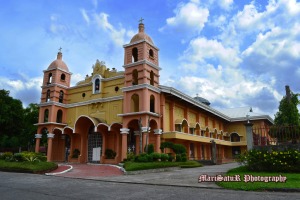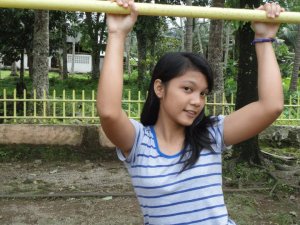Alang-alang is a 4th class municipality in the province of Leyte, Philippines. It is a landlocked province with an area of 151 km². It is bounded on the north by Barugo and San Miguel, on the south by Pastrana, on the northeast by Tacloban City, on the east by Santa Fe and on the west by Jaro. According to the 2000 census, it has a population of 41,245 people in 8,188 households.
On the way to Carigara is a steel bridge spanning the Mainit River. Soon after it is a smaller bridge. There was a time when only footpaths existed and when this river was too wide for a leap and too narrow to wade in, the traveler was undecided what to do. Hence the name Alangalang was given to the town, from the vernacular word “alang-alang” which means indecision.
LINGGANAY FESTIVAL
 The Lingganay Festival of Alang-alang town was the champion last year’s Pintados Kasadyaan Festival, besting nine other entries from different towns of Leyte to win the P500,000 cash prize.
The Lingganay Festival of Alang-alang town was the champion last year’s Pintados Kasadyaan Festival, besting nine other entries from different towns of Leyte to win the P500,000 cash prize.
The Pintados-Kasadyaan Festival of Festivals will always be a showdown of the best dance contingents in Eastern Visayas and one of the best festivals in the country.
Though tension ran high during the grand parade, this year’s main festival was successfully staged at the Leyte Sports Development Center, where festivals from different towns in Leyte featured their most colorful displays of pomp and pageantry: participants garbed in bright-colored costumes dance to the rhythm of drums, trumpets, and native gongs.
Fifteen colorfully attired Kasadyaan contingents, representing festivals of the towns in Leyte, and 10 “pintados” (tribes) denoting the early settlers compete in the ritual dancing contest.
Early favorite Lingganay Festival of Alangalang, Leyte was this year’s grand champion in the Kasadyaan festival dance category. Lingganay is a pageant depicting the legendary and mythical story of the bells.
Lingganay Festival received P500,000 cash prize and will vie in the annual Aliwan Fiesta, the country’s premiere festival competition during summer.
Placing second was the Karatong Festival of Dulag, Leyte. The Dulag contingent brought with them karatongs, a percussion instrument made out of bamboos that serves as signaling device by the natives of the town at the height of Moro raids. Karatong Festival also bagged the Best in Festival Music.
Pamilipig Festival of Sta. Fe, Leyte, a portrayal of the old tradition of making pilipig after rice harvest placed third.
Runners-up in the Kasadyaan category were Viajedores Festival of La Paz, Leyte; Tulo-usa Festival of Tolosa, Leyte; Batobalani Festival of Bato, Leyte; Lubi-lubi Festival of Calubian, Leyte; Tamyuk Festival of Tunga, Leyte; Tambula Festival of Babatngon, Leyte; and Lantawan Festival of Capoocan, Leyte.
In the Pindados-based category, one of the crowd favorites, Tribu Mangirisda, grabbed this year’s championship.
Tribu Kasarakyan and Tribu Bangkawanon, placed second and third respectively.
The Pintados-Kasadyaan Festival of Festivals is a merry-making event highlighting the Leyte Kasadyaan Festivals, the Pintados Festival Ritual Dance Presentation and the grand parade. These festivals are said to have began from the feast day of Señor Santo Niño.
The Leyteños celebrate a religious festival in a unique and colorful way. Since the Visayans are experienced in the art of body tattooing, men and women are fond of tattooing themselves.
The Pintados Festival displays the rich cultural heritage, incorporating native music and dances, of the people of Leyte and Samar. The Leyte Kasadya-an Festival of Festivals, meanwhile, showcases the unique culture and colorful history of the Province of Leyte.



























